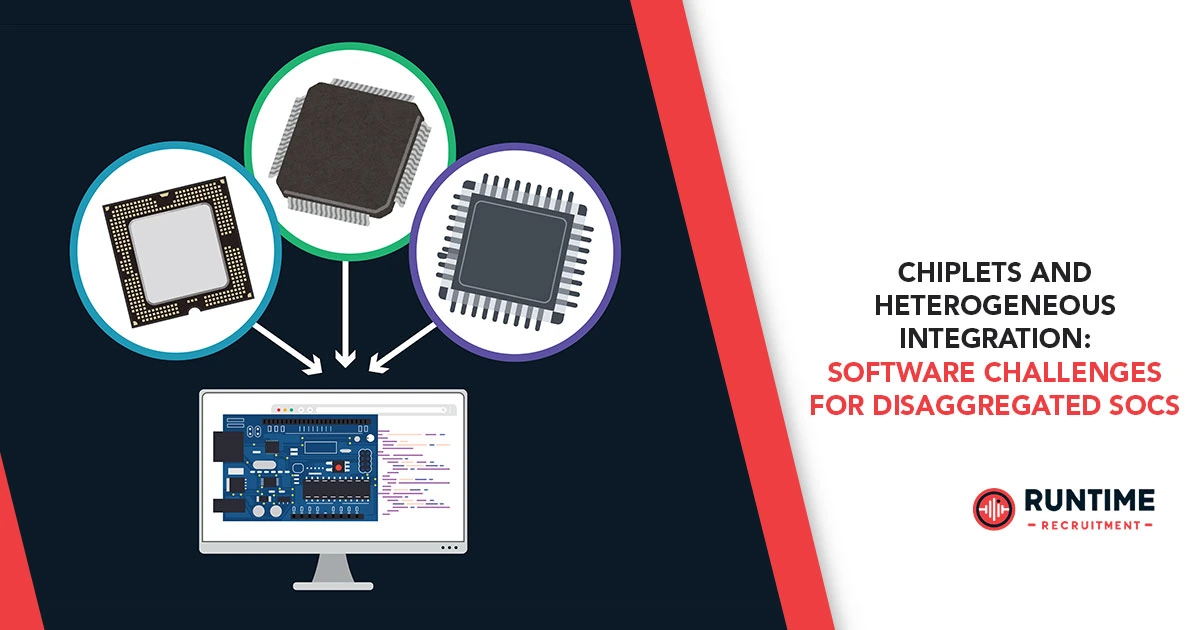The relentless march of Moore’s Law, while not entirely stalled, is certainly encountering significant headwinds. As Dennard scaling falters and the physical limits of transistor miniaturization become increasingly apparent, the semiconductor industry is turning to innovative architectural paradigms to continue delivering performance improvements and power efficiency gains. Among these, chiplets and heterogeneous integration have emerged as frontrunners, promising a new era of highly customized, optimized, and scalable System-on-Chips (SoCs).
Gone are the days when a single, monolithic die housed all the complex functionalities of an SoC. The chiplet approach disaggregates the traditional SoC into smaller, specialized “chiplets,” each manufactured using the most appropriate process technology for its function. These chiplets, be it a high-performance CPU, a dedicated GPU, an AI accelerator, or specialized I/O, are then interconnected within a single package, forming a “disaggregated SoC.” This heterogeneous integration allows for unparalleled flexibility, enabling designers to mix and match the best-in-class components, optimize manufacturing costs, and potentially extend the lifespan of mature process nodes for less demanding functionalities.
However, this exciting new frontier is not without its significant hurdles. While the hardware advantages are clear, the software implications for disaggregated SoCs are profound and present a complex tapestry of challenges that embedded engineers must navigate. This article delves into these software complexities, exploring the fundamental shifts required in design methodologies, development tools, and operational paradigms.
The Interconnect – More Than Just Wires
At the heart of any disaggregated SoC lies the interconnect fabric that binds the disparate chiplets together. Unlike the relatively uniform and tightly integrated on-die interconnects of monolithic SoCs, chiplet-based designs introduce a new layer of complexity. Standards like UCIe (Universal Chiplet Interconnect Express) are emerging to facilitate interoperability, but the underlying physical and logical characteristics of these interconnects can vary significantly.
From a software perspective, this means that simple assumptions about memory access latency, bandwidth, and cache coherence, which held true for monolithic designs, are no longer guaranteed. Software needs to become acutely aware of the “topology” of the chiplet system – which chiplets are connected to which, the characteristics of those connections, and the implications for data movement.
Consider a scenario where a CPU chiplet needs to access data held in memory associated with an AI accelerator chiplet. The path taken by this data, the latency incurred, and the potential for contention on the interconnect can be vastly different from accessing data within the CPU’s local cache or main memory. Software, particularly operating systems and middleware, must be designed to effectively manage these varying latencies and bandwidths. This could involve intelligent data placement strategies, dynamic task scheduling that considers data locality across chiplets, and even active power management that understands the energy implications of inter-chiplet communication.
Furthermore, ensuring cache coherence across a disaggregated SoC is a monumental task. While hardware mechanisms will provide the foundational support, software must be designed to leverage these mechanisms efficiently and to handle potential coherence issues that might arise from complex data sharing patterns between chiplets. Debugging coherence problems in such a distributed system promises to be significantly more challenging than in a monolithic architecture.
Memory Hierarchy Reimagined: The Software Perspective
In a monolithic SoC, the memory hierarchy is generally well-defined and relatively predictable. With chiplets, this hierarchy becomes significantly more complex and distributed. Each chiplet may have its own local caches, local memory controllers, and even different types of memory (e.g., HBM, DDR, LPDDR). The challenge for software is to manage this heterogeneous memory landscape effectively, ensuring optimal data access patterns and minimizing performance bottlenecks.
Operating systems and hypervisors will need to evolve to become “memory topology aware.” This means understanding not just the total amount of available memory, but also where that memory resides, its characteristics (latency, bandwidth), and how it’s connected to different processing units. Memory allocation algorithms will need to be refined to consider the “cost” of accessing memory from different chiplets. For instance, an application running on a CPU chiplet might perform significantly better if its working set is allocated in memory physically close to that CPU, even if other, theoretically faster, memory is available on a different chiplet further away.
Virtual memory management also faces new complexities. Paging and memory protection schemes will need to account for the distributed nature of memory. Swapping data between different types of memory and across chiplet boundaries could introduce unexpected performance penalties if not handled intelligently. Software developers will need new tools and abstractions to reason about and manage this intricate memory landscape, perhaps moving towards more explicit memory management in certain performance-critical applications.
Resource Management and Scheduling in a Distributed World
Traditional operating systems are designed to manage resources – CPU cores, memory, I/O – within a single, cohesive hardware unit. Disaggregated SoCs fundamentally challenge this model. Now, the “system” is composed of multiple independent hardware units, each with its own resources and characteristics.
This necessitates a re-thinking of resource management and scheduling. How does an operating system intelligently schedule tasks across chiplets with varying processing capabilities and specialized accelerators? How does it balance workloads to optimize for performance, power, and thermal constraints across the entire disaggregated SoC?
Consider a task that could potentially run on either a general-purpose CPU chiplet or a specialized accelerator chiplet. The scheduler needs to make intelligent decisions based on the current system load, the specific requirements of the task, the data locality, and the power implications of using one chiplet over another. This will require sophisticated heuristics, potentially incorporating machine learning, to dynamically adapt to changing workloads and system conditions.
Furthermore, fault tolerance and reliability become more critical. If one chiplet fails, how does the system gracefully degrade or reconfigure itself to continue operation? Software will need to implement robust error detection, isolation, and recovery mechanisms that span across chiplet boundaries. This could involve checkpointing application states, migrating tasks to healthy chiplets, and dynamically re-routing communication paths.
Debugging and Profiling: Navigating the Labyrinth
Debugging and profiling complex systems are already challenging endeavors. With disaggregated SoCs, these challenges are amplified significantly. The traditional tools and methodologies, often designed for monolithic architectures, may prove inadequate in this new paradigm.
Imagine trying to track down a performance bottleneck or a subtle bug in a system where execution paths can jump between multiple physically distinct chiplets, each potentially running different microarchitectures and even different clock domains. Pinpointing the exact source of an issue, understanding inter-chiplet communication patterns, and visualizing data flow across the entire system will require a new generation of debugging and profiling tools.
These tools will need to offer:
- System-wide visibility: The ability to observe and analyze events across all chiplets simultaneously, providing a holistic view of the system’s behavior.
- Inter-chiplet communication tracing: Detailed insights into the traffic patterns, latencies, and potential bottlenecks on the interconnect fabric.
- Heterogeneous introspection: The capability to inspect the internal state of different chiplet types, even if they have vastly different instruction sets or debugging interfaces.
- Coherence visualization: Tools to help developers understand and diagnose cache coherence issues across chiplet boundaries.
- Power and thermal mapping: The ability to correlate software activity with power consumption and thermal profiles across individual chiplets, aiding in power optimization.
The development of such sophisticated debugging and profiling infrastructure will be crucial for the widespread adoption and successful deployment of disaggregated SoCs. Without adequate visibility into the system’s behavior, software development will remain a trial-and-error process, hindering innovation and increasing time-to-market.
The Toolchain Evolution: Compilers, Runtimes, and Abstractions
The entire software toolchain, from compilers to runtime environments, needs to evolve to embrace the complexities of disaggregated SoCs.
Compilers: Traditional compilers are optimized for specific instruction sets and target architectures. With heterogeneous integration, compilers will need to become more intelligent, capable of identifying code sections that can benefit from offloading to specialized accelerator chiplets and generating appropriate code for those targets. This will require advanced program analysis techniques, automatic parallelization capabilities, and support for heterogeneous instruction sets within a single compilation flow. Furthermore, compilers might need to generate code that is aware of memory locality and inter-chiplet communication costs, perhaps through specialized pragmas or language extensions.
Runtimes: The runtime environments for applications will need to abstract away much of the underlying chiplet complexity. This includes managing data movement between chiplets, scheduling tasks on appropriate processing units, and ensuring data consistency. Frameworks like OpenCL, SYCL, and specialized AI frameworks (e.g., TensorFlow, PyTorch) are already moving in this direction, but they will need to be extended to fully exploit the capabilities of disaggregated SoCs. This might involve dynamic runtime optimization that adapts to the specific chiplet configuration and workload at hand.
Programming Models and Abstractions: Developers cannot be expected to manage every detail of inter-chiplet communication, memory coherence, and resource scheduling manually. New programming models and higher-level abstractions are essential to simplify the development process. These abstractions should allow developers to express their applications’ parallelism and data dependencies without getting bogged down in the intricacies of the underlying hardware. This could involve message-passing interfaces, shared memory paradigms with distributed coherence semantics, or specialized domain-specific languages (DSLs) that target heterogeneous architectures.
Security and Trust in a Disaggregated World
Security is a paramount concern in any modern computing system, and disaggregated SoCs introduce new attack surfaces and challenges. Each chiplet could potentially originate from a different vendor, be manufactured at a different fab, and have different security guarantees.
Software will play a critical role in establishing and maintaining trust across these disparate components. This includes:
- Secure Boot and Attestation: Ensuring that each chiplet boots securely and that its firmware and software components are genuine and untampered with. This will require distributed secure boot mechanisms that can verify the integrity of each chiplet in the system.
- Inter-Chiplet Communication Security: Protecting the communication channels between chiplets from eavesdropping, tampering, and denial-of-service attacks. This could involve hardware-accelerated encryption and authentication protocols for inter-chiplet links.
- Isolation and Containment: Implementing robust isolation mechanisms to prevent a compromised chiplet from affecting the security of other chiplets or the entire system. Micro-kernel architectures and hardware-enforced isolation techniques will be critical here.
- Key Management: Securely managing cryptographic keys across multiple chiplets, potentially from different trust domains.
- Supply Chain Security: Verifying the authenticity and integrity of each chiplet throughout its lifecycle, from manufacturing to deployment.
The trusted computing base (TCB) of a disaggregated SoC becomes significantly larger and more distributed, making security assurance a more complex and critical endeavor.
The Path Forward for Embedded Engineers
The transition to chiplets and heterogeneous integration is not merely an incremental hardware change; it demands a fundamental shift in how embedded software is conceived, designed, developed, and deployed. For embedded engineers, this presents both significant challenges and immense opportunities.
To thrive in this evolving landscape, engineers will need to:
- Deepen their understanding of hardware architectures: A more intimate knowledge of interconnects, memory hierarchies, and the specific characteristics of different chiplet types will be essential.
- Embrace parallel and distributed programming: The days of purely sequential programming for embedded systems are increasingly numbered.
- Become proficient in heterogeneous computing paradigms: Understanding how to effectively utilize specialized accelerators and offload workloads.
- Master new debugging and profiling techniques: Adapting to tools and methodologies designed for distributed systems.
- Prioritize security from the ground up: Designing secure software architectures that account for the unique vulnerabilities of disaggregated SoCs.
- Engage with emerging standards: Actively participate in or follow the development of standards like UCIe and other chiplet-related initiatives.
- Adopt agile development methodologies: The complexity of these systems will necessitate iterative development, continuous integration, and rapid prototyping.
The future of high-performance and power-efficient computing lies in the intelligent integration of specialized chiplets. While the hardware innovation is paving the way, it is the software that will truly unlock the full potential of these disaggregated SoCs. The challenges are substantial, but the rewards – in terms of performance, efficiency, and customizability – are even greater. Embedded engineers are at the forefront of this revolution, poised to shape the next generation of computing platforms.
Seeking your next challenge in embedded systems? Connect with RunTime Recruitment today to explore cutting-edge opportunities in chiplet and heterogeneous integration projects.









